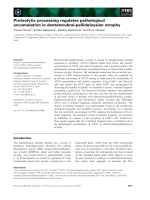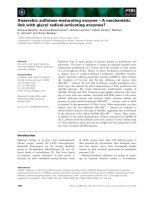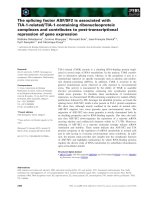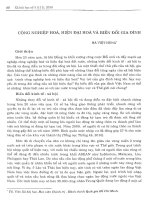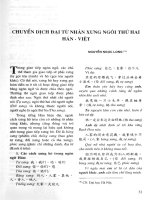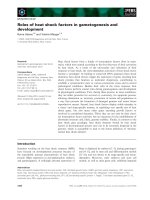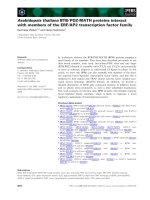Tài liệu Báo cáo khoa học: "RELATING COMPLEXITY TO PRACTICAL PERFORMANCE IN PARSING WITH WIDE-COVERAGE UNIFICATION GRAMMARS" pptx
Bạn đang xem bản rút gọn của tài liệu. Xem và tải ngay bản đầy đủ của tài liệu tại đây (789.74 KB, 8 trang )
RELATING COMPLEXITY TO PRACTICAL
PERFORMANCE IN PARSING WITH WIDE-COVERAGE
UNIFICATION GRAMMARS
John Carroll
University of Cambridge, Computer Laboratory
Pembroke Street, Cambridge CB2 3QG, UK
Abstract
The paper demonstrates that exponential com-
plexities with respect to grammar size and input
length have little impact on the performance of
three unification-based parsing algorithms, using
a wide-coverage grammar. The results imply that
the study and optimisation of unification-based
parsing must rely on empirical data until complex-
ity theory can more accurately predict the practi-
cal behaviour of such parserQ.
1. INTRODUCTION
General-purpose natural language (NL) analysis
systems have recently started to use declarative
unification-based sentence grammar formalisms;
systems of this type include SRI's CLARE sys-
tem (Alshawi
et al.,
1992) and the A1vey NL Tools
(ANLT; Briscoe
et al.,
1987a). Using a declarative
formalism helps ease the task of developing and
maintaining the grammar (Kaplan, 1987). In ad-
dition to syntactic processing, the systems incor-
porate lexical, morphological, and semantic pro-
cessing, and have been applied successfully to the
analysis of naturally-occurring texts (e.g. Alshawi
et al.,
1992; Briscoe & Carroll, 1993).
Evaluations of the grammars in these par-
ticular systems have shown them to have wide
coverage (Alshawi
et al.,
1992; Taylor, Grover &=
Briscoe, 1989) 2. However, although the practical
throughput of parsers with such realistic gram-
mars is important, for example when process-
1This research was supported by SERC/DTI
project 4/1/1261 'Extensions to the Alvey Natu-
ral Language Tools' and by EC ESPRIT BRA-7315
'ACQUILEX-II'. I am grateful to Ted Briscoe for com-
ments on an earlier version of this paper, to David
Weir for valuable discussions, and to Hiyan Alshawi
for assistance with the CLARE system.
2For
example, Taylor
et al.
demonstrate that the
ANLT grammar is in principle able to analyse 96.8%
of a corpus of 10,000 noun phrases taken from a variety
of corpora.
ing large amounts of text or in interactive ap-
plications, there is little published research that
compares the performance of different parsing
algorithms using wide-coverage unification-based
grammars. Previous comparisons have either fo-
cussed on context-free (CF) or augmented CF
parsing (Tomita, 1987; Billot & Lang, 1989),
or have used relatively small, limited-coverage
unification grammars and lexicons (Shann, 1989;
Bouma & van Noord, 1993; Maxwell & Kaplan,
1993). It is not clear that these results scale
up to reflect accurately the behaviour of parsers
using realistic, complex unification-based gram-
mars: in particular, with grammars admitting less
ambiguity parse time will tend to increase more
slowly with increasing input length, and also with
smaller grammars rule application can be con-
strained tightly with relatively simple predictive
techniques. Also, since none of these studies relate
observed performance to that of other comparable
parsing systems, implementational oversights may
not be apparent and so be a confounding factor in
any general conclusions made.
Other research directed towards improving
the throughput of unification-based parsing sys-
tems has been concerned with the unification oper-
ation itself, which can consume up to 90% of parse
time (e.g. Tomabechi, 1991) in systems using lex-
icalist grammar formalisms (e.g. HPSG; Pollard
& Sag, 1987). However, parsing algorithms as-
sume more importance for grammars having more
substantial phrase structure components, such as
CLARE (which although employing some HPSG-
like analyses still contains several tens of rules)
and the ANLT (which uses a formalism derived
from GPSG; Gazdar
et al.,
1985), sincethe more
specific rule set can be used to control which uni-
fications are performed.
In NL analysis, the syntactic information as-
sociated with lexical items makes top-down pars-
ing less attractive than bottom-up (e.g. CKY;
Kasami, 1965; Younger, 1967), although the lat-
ter is often augmented with top-down predic-
287
tion to improve performance (e.g. Earley, 1970;
Lang, 1974; Pratt, 1975). Section 2 describes
three unification-based parsers which are related
to polynomial-complexity bottom-up CF parsing
algorithms. Although incorporating unification
increases their complexity to exponential on gram-
mar size and input length (section 3), this ap-
pears to have little impact on practical perfor-
mance (section 4). Sections 5 and 6 discuss these
findings and present conclusions.
2. THE PARSERS
The three parsers in this study are: a bottom-
up left-corner parser, a (non-deterministic) LR
parser, and an LR-like parser based on an algo-
rithm devised by Schabes (1991). All three parsers
accept grammars written in the ANLT formal-
ism (Briscoe
et al.,
1987a), and the first two are
distributed as part of the ANLT package. The
parsers create parse forests (Tomita, 1987) that
incorporate subtree sharing (in which identical
sub-analyses are shared between differing super-
ordinate analyses) and node packing (where sub-
analyses covering the same portion of input whose
root categories are in a subsumption relationship
are merged into a single node).
THE BOTTOM-UP LEFT-CORNER
PARSER
The bottom-up left-corner (BU-LC) parser oper-
ates left-to-right and breadth-first, storing partial
(active) constituents in a chart; Carroll (1993)
gives a full description. Although pure bottom-
up parsing is not usually thought of as provid-
ing high performance, the actual implementation
achieves very good throughput (see section 4) due
to a number of significant optimisations, amongst
which are:
• Efficient rule invocation from cheap (static) rule
indexing, using discrimination trees keyed on
the feature values in each rule's first daughter
to interleave rule access with unification and
also to share unification results across groups
of rules.
• Dynamic indexing of partial and complete con-
stituents on category types to avoid attempt-
ing unification or subsumption operations which
static analysis shows will always fail.
• Dynamic storage minimisation, deferring struc-
ture copying e.g, required by the unification
operation or by constituent creation until ab-
solutely necessary (e.g. unification success or
parse success, respectively).
The optimisations improve throughput by a factor
of more than three.
THE NON-DETERMINISTIC LR
PARSER
Briscoe & Carroll (1993) describe a methodology
for constructing an LR parser for a unification-
based grammar, in which a CF 'backbone' gram-
mar is automatically constructed from the unifi-
cation grammar, a parse table is constructed from
the backbone grammar, and a parser is driven by
the table and further controlled by unification of
the 'residue' of features in the unification gram-
mar that are not encoded in the backbone. In
this parser, the LALR(1) technique (Aho, Sethi
Ullman, 1986) is used, in conjunction with
a graph-structured stack (Tomita, 1987), adapt-
ing for unification-based parsing Kipps' (1989)
Tomita-like recogniser that achieves polynomial
complexity on input length through caching.
On each reduction the parser performs the
unifications specified by the unification grammar
version of the CF backbone rule being applied.
This constitutes an on-line parsing algorithm. In
the general case, the off-line variant (in which all
unifications are deferred until the complete CF
parse forest has been constructed) is not guaran-
teed to terminate; indeed, it usually does not do so
with the ANLT grammar. However, a drawback
to the on-line algorithm is that a variant of Kipps'
caching cannot be used, since the cache must nec-
essarily assume that all reductions at a given ver-
tex with all rules with the same number of daugh-
ters build exactly the same constituent every time;
in general this is not the case when the daughters
are unification categories. A weaker kind of cache
on partial analyses (and thus unification results)
was found to be necessary in the implementation,
though, to avoid duplication of unifications; this
sped the parser up by a factor of about three, at
little space cost.
THE COMPILED-EARLEY PARSER
The Compiled-Earley (CE) parser is based on a
predictive chart-based CF parsing algorithm de-
vised by Schabes (1991) which is driven by a table
compiling out the predictive component of Ear-
ley's (1970) parser. The size of the table is related
linearly to the size of the grammar (unlike the LR
technique). Schabes demonstrates that this parser
always takes fewer steps than Earley's, although
its time complexity is the same: O(n3). The space
complexity is also cubic, since the parser uses Ear-
ley's representation of parse forests.
The incorporation of unification into the CE
parser follows the methodology developed for
unification-based LR parsing described in the pre-
vious section: a table is computed from a CF
'backbone', and a parser, augmented with on-line
unification and feature-based subsumption opera-
288
tions, is driven by the table. To allow meaningful
comparison with the LR parser, the CE parser uses
a one-word lookahead version of the table, con-
structed using a modified LALR technique (Car-
roll, 1993) 3 .
To achieve the cubic time bound, the parser
must be able to retrieve in unit time all items in
the chart having a given state, and start and end
position in the input string. However, the obvious
array implenmntation, for say a ten word sentence
with the ANLT grammar, would contain almost
500000 elements. For this reason, the implementa-
tion employs a sparse representation for the array,
since only a small proportion of the elements are
ever filled. In this parser, the same sort of dupli-
cation of ratifications occurs as in the LR parser,
so lists of partial analyses are cached in the same
way.
3. COMPLEXITIES OF THE
PARSERS
The two wu'iables that determine a parser's com-
l)utational complexity are the grammar and the
input string (Barton, Berwick &: Ristad, 1987).
These are considered separately in the next two
sections.
GRAMMAR-DEPENDENT
COMPLEXITY
The term dependent on tile grammar in the time
complexity of the BU-LC unification-based parser
described above is O(IC[2[RI3), where ICI is the
number of categories implicit in the grammar, and
]RI, the number of rules. The space complexity is
dominated by the size of the parse forest, O(]C[)
(these results are proved by Carroll, 1993). For
the ANLT grammar, in which features are nested
to a maximum depth of two, ICI is finite but nev-
ertheless extremely large (Briscoe
et al.,
1987b) 4.
The grammar-dependent complexity of the
LR parser makes it also appear intractable: John-
son (1989) shows that the number of LR(0) states
for certain (pathological) grammars is exponen-
tially related to the size of the grammar, and that
there are some inputs which force an LR parser
to visit all of these states in the course of a parse.
aSchabes describes a table with no lookahead; the
successful application of this technique supports Sch-
abes' (1991:109) assertion that "several other methods
(such as LR(k)-like and SLR(k)-like) can also be used
for constructing the parsing tables [ ]"
aBarton, Berwick & Ristad (1987:221) calculate
that GPSG, also with a maximum nesting depth of
two, licences more than 10 rr5 distinct syntactic cate-
gories. The number of categories is actually infinite in
grammars that use a fully recursive feature system.
Thus the total number of operations performed,
and also space consumed (by the vertices in the
graph-structured stack), is an exponential func-
tion of the size of the grammar.
To avoid this complexity, the CE parser em-
ploys a table construction method which ensures
that the number of states in the parse table is
linearly related to the size of the grammar, re-
sulting in the number of operations performed by
the parser being at worst a polynomial function of
grammar size.
INPUT-DEPENDENT
COMPLEXITY
Although the complexity of returning all parses
for a string is always related exponentially to its
length (since the number of parses is exponen-
tial, and they must all at least be enumerated),
the complexity of a parser is usually measured for
the computation of a parse forest (unless extract-
ing a single analysis from the forest is worse than
linear) 5.
If one of the features of the ANLT grammar
formalism, the kleene operator (allowing indefinite
repetition of rule daughters), is disallowed, then
the complexity of the BU-LC parser with respect
to the length of the input string is
O(np+l),
where
p is the maximum number of daughters in a rule
(Carroll, 1993). The inclusion of the operator in-
creases the complexity to exponential. To retain
the polynomial time bound, new rules can be in-
troduced to produce recursive tree structures in-
stead of an iterated fiat tree structure. However,
when this technique is applied to the ANLT gram-
mar the increased overheads in rule invocation and
structure building actually slow the parser down.
Although the time and space complexities of
CF versions of the LR and CE parsers are O(n3),
the unification versions of these parsers both turn
out to have time bounds that are greater than cu-
bic, in the general case. The CF versions implicitly
pack identical
sequences
of sub-analyses, and in
all reductions at a given point with rules with the
same number of daughters, the packed sequences
can be formed into higher-level constituents as
they stand without further processing. However,
in the unification versions, on each reduce action
the daughters of the rule involved have to be uni-
fied with every possible alternative sequence of the
sub-analyses that are being consumed by the rule
5This complexity measure does correspond to real
world usage of a parser, since practical systems can
usually afford to extract only a small number of parses
from the frequently very large number encoded in a
forest; this is often done on the basis of preference-
based or probabilistic factors (e.g. Carroll & Briscoe,
1992).
289
(in effect expanding and flattening out the packed
sequences), leading to a bound of n p+I on the total
number of unifications.
4. PRACTICAL RESULTS
To assess the practical performance of the three
unification-based parsers described above, a series
of experiments were conducted using the ANLT
grammar (Grover, Carroll & Briscoe, 1993), a
wide-coverage grammar of English. The gram-
mar is defined in metagrammatical formalism
which is compiled into a unification-based 'ob-
ject gran~mar' a syntactic variant of the Defi-
nite Clause Grammar formalism (Pereira & War-
ren, 1980) containing 84 features and 782 phrase
structure rules. Parsing uses fixed-arity term uni-
fication. The grammar provides full coverage
of the following constructions: declarative sen-
tences, imperatives and questions (yes/no, tag and
wh-questions); all unbounded dependency types
(topicalisation, relativisation, wh-questions); a
relatively exhaustive treatment of verb and ad-
jective complement types; phrasal and preposi-
tional verbs of many complement types; passivi-
sation; verb phrase extraposition; sentence and
verb phrase modification; noun phrase comple-
ments and pre- and post-modification; partitives;
coordination of all major category types; and nom-
inal and adjectival comparatives.
Although the grammar is linked to a lexi-
con containing definitions for 40000 base forms of
words, the experiments draw on a much smaller
lexicon of 600 words (consisting of closed class
vocabulary and, for open-class vocabulary, defi-
nitions of just a sample of words which taken to-
gether exhibit the full range of possible comple-
mentation patterns), since issues of lexical cover-
age are of no concern here.
COMPARING THE PARSERS
In the first experiment, the ANLT grammar was
loaded and a set of sentences was input to each
of the three parsers. In order to provide an inde-
pendent basis for comparison, the same sentences
were also input to the SRI Core Language En-
gine (CLE) parser (Moore & Alshawi, 1992) with
the CLARE2.5 grammar (Alshawi
et al.,
1992), a
state-of-the-art system accessible to the author.
The sentences were taken from an initial sam-
ple of 175 representative sentences extracted from
a corpus of approximately 1500 that form part of
the ANLT package. This corpus, implicitly defin-
ing the types of construction the grammar is in-
tended to cover, was written by the linguist who
developed the ANLT grammar and is used to check
for any adverse effects on coverage when the gram-
mar is modified during grammar development. Of
Parser Grammar CPU time Storage
allocated
47.0
BU-LC
LR
CE
CLE
ANLT
ANLT
ANLT
CLARE2.5
75.5
48.9
98.4
277.7
33.6
38.5
Table 1: Parse times (in CPU seconds on a Sun
Sparc ELC workstation) and storage allocated (in
megabytes) while parsing the 129 test sentences
(1-12 words in length).
the initial 175 sentences, the CLARE2.5 grammar
failed to parse 42 (in several cases because punc-
tuation is strictly required but is missing from the
corpus). The ANLT grammar also failed to parse
three of these, plus an additional four. These sen-
tences were removed from the sample, leaving 129
(mean length 6.7 words) of which 47 were declar-
ative sentences, 38 wh-questions and other sen-
tences with gaps, 20 passives, and 24 sentences
containing co-ordination.
Table 1 shows the total parse times and stor-
age allocated for the BU-LC parser, the LR parser,
and the CE parser, all with ANLT grammar
and lexicon. All three parsers have been im-
plemented by the author to a similar high stan-
dard: similar implementation techniques are used
in all the parsers, the parsers share the same uni-
fication module, run in the same Lisp environ-
ment, have been compiled with the same optimisa-
tion settings, and have all been profiled with the
same tools and hand-optimised to a similar ex-
tent. (Thus any difference in performance of more
than around 15% is likely to stem from algorithmic
rather than implementational reasons). Both of
the predictive parsers employ one symbol of looka-
head, incorporated into the parsing tables by the
LALR technique. Table 1 also shows the results
for the CLE parser with the CLARE2.5 grammar
and lexicon. The figures include garbage collection
time, and phrasal (where appropriate) processing,
but not parse forest unpacking. Both grammars
give a total of around 280 analyses at a similar
level of detail.
The results show that the LR parser is ap-
proximately 35% faster than the BU-LC parser,
and allocates about 30% less storage. The mag-
nitude of the speed-up is less than might be ex-
pected, given the enthusiastic advocation of non-
deterministic CF LR parsing for NL by some re-
searchers (e.g. Tomita, 1987; Wright, Wrigley &
Sharman, 1991), and in the light of improvements
observed for predictive over pure bottom-up pars-
ing (e.g. Moore & Dowding, 1991). However, on
the assumption that incorrect prediction of gaps is
290
the main avoidable source of performance degra-
dation (c.f. Moore & Dowding), further investiga-
tion shows that the speed-up is near the maximum
that is possible with the ANLT grammar (around
50%).
The throughput of the CE parser is half that
of the LR parser, and also less than that of the
BU-LC parser. However, it is intermediate be-
tween the two in terms of storage allocated. Part
of the difference in performance between it and
the LR parser is due to the fact that it performs
around 15% more unifications. This might be
expected since the corresponding finite state au-
tomaton is not determinised to avoid theoretical
exponential time complexity on grammar size~
thus paying a price at run time. Additional rea-
sons for the relatively poor performance of the CE
parser are the overheads involved in maintaining
a sparse representation of the chart, and the fact
that with the ANLT grammar it generates less
"densely packed" parse forests, since its parse ta-
ble, with 14% more states (though fewer actions)
than the LALR(1) table, encodes more contextual
distinctions (Billot & Lang, 1989:146).
Given that the ANLT and CLARE2.5 gram-
mars have broadly similar (wide) coverage and re-
turn very similar numbers of syntactic analyses for
the same inputs, the significantly better through-
lint of the three parsers described in this paper
ovcr the CLE parser 6 indicates that they do not
contain any significant implementational deficien-
cies which would bias the results 7.
SWAPPING THE GRAMMARS
OVER
A second experiment was carried out with the
CLE parser, in which the built-in grammar and
lexicon were replaced by versions of the ANLT ob-
ject grammar and lexical entries translated (auto-
matically) into the CLE formalism. (The reverse
of this configuration, in which the CLARE2.5
grammar is translated into the ANLT formalism,
is not possible since some central rules contain
sequences of daughters specified by a single 'list'
variable, which has no counterpart in the ANLT
and cannot directly be simulated). The through-
~Although the ANLT parser is implemented in
Common Lisp and the CLE parser in Prolog, compar-
ing parse times is a valid exercise since current com-
piler and run-time support technologies for both lan-
guages are quite well-developed, and in fact the CLE
parser takes advantage of Prolog's built-in unification
operation which will have been very tightly coded.
7The ANLT's speed advantage over CLARE is less
pronounced if the time for morphological analysis and
creation of logical forms is taken into account, proba-
bly because the systems use different processing tech-
niques in these modules.
put of this configuration was only one fiftieth of
that of the BU-LC parser. The ANLT grammar
contains more than five times as many rules than
does the sentence-level portion of the CLARE2.5
grammar, and Alshawi (personal communication)
points out that the CLE parser had not previously
been run with a grammar containing such a large
number of rules, in contrast to the ANLT parsers.
THE EFFECT OF SENTENCE
LENGTH
Although the mean sentence length in the first two
experiments is much shorter than the 20-30 word
length (depending on genre etc.) that is common
in real texts, the test sentences cover a wide range
of syntactic constructions and exhibit less con-
structional bias than would a set of sentences ex-
tracted at random from a single corpus. However,
to investigate performance on longer sentences and
the relationship between sentence length and parse
time, a further set of 100 sentences with lengths
distributed uniformly between 13 and 30 words
was created by hand by the author and added to
the previous test data. Table 2 shows the relation-
ship between sentence length and mean parse time
with the BU-LC and LR parsers.
In contrast to the results from the first exper-
iment, the throughput of the LR parser is only
4% better than that of the BU-LC parser for sen-
tences of 13-27 words in length. The former parses
many sentences up to twice as fast, but a small
proportion of the others are parsed almost twice
as slowly. As well as their wide variability with
respect to the BU-LC parser, the absolute vari-
ability of the LR parse times is high (reflected in
large standard deviations a see Table 2). Most
of the sentences for which LR performance is worse
contain more than one occurrence of the passive
construction: due to their length this is particu-
larly the case for the group of sentences of 28-30
words with which the LR parser performed partic-
ularly badly. However, it is likely that if the con-
straining power of the parse table were improved
in this area the difference in throughput between
LR and BU-LC would revert to nearer the 35%
figure seen in the first experiment.
The standard deviations for numbers of parses
are also relatively large. The maximum number of
parses was 2736 for one 29-word sentence, but on
the other hand some of even the longest sentences
had fewer than ten parses. (But note that since
the time taken for parse forest unpacking is not
included in parse times, the latter do not vary by
such a large magnitude).
The results of this experiment are displayed
graphically in Figure 1, together with a quadratic
function. Comparison with the function suggests
291
Sentence
length
(words)
1-3
4-6
7-9
10-12
13-15
16-18
19-21
22-24
25-27
28-30
BU-LC
Parse time
Mean a
0.11 0.06
0.23 0.18
0.42 0.24
1.17 0.92
0.97 0.28
1.92 0.75
3.54 1.42
3.87 1.62
5.45 1.98
7.86 2.37
LR
Parse time
Mean a
0.05 0.02
0.15 0.11
0.28 0.17
0.76 0.52
0.86 0.38
1.89 1.00
3.74 2.46
3.61 3.07
5.05 3.59
12.89 5.65
Number of
parses
Mean a
1.3 0.7
1.4 0.8
1.8 1.3
3.8 2.4
10.0 13.7
14.3 17.5
60.1 117.3
143.8 200.1
168.8 303.1
343.5 693.7
Table 2: Mean and standard deviation parse times (in CPU seconds on an HP9000/710 workstation), and
numbers of parses for the 229 test sentences (1-30 words in length) with the BU-LC and LR parsers.
that, at least for the BU-LC parser, parse time is
related roughly quadratically to input length.
In previous work with the ANLT (Briscoe &
Carroll, 1993), throughput with raw corpus data
was worse than that observed in these experi-
ments, though probably only by a constant factor.
This could be due to the fact that the vocabu-
lary of the corpus concerned exhibits significantly
higher lexical ambiguity; however, for sentences
taken from a specific corpus, constructional bias
observed in a training phase could be exploited to
improve performance (e.g. Samuelsson &: Rayner,
1991).
5. DISCUSSION
All three of the parsers have theoretical worst-case
complexities that are either exponential, or poly-
nomial on grammar size but with an extremely
large multiplier. Despite this, in the practical
experiments reported in the previous section the
parsers achieve relatively good throughput with a
general-purpose wide-coverage grammar of a nat-
ural language. It therefore seems likely that gram-
mars of the type considered in this paper (i.e. with
relatively detailed phrase structure components,
but comparatively simple from a unification per-
spective), although realistic, do not bring the pars-
ing algorithms involved anywhere near the worst-
case complexity.
In the experiments, the CE technique results
in a parser with worse performance than the nor-
mal LR technique. Indeed, for the ANLT gram-
mar, the number of states the term that the CE
technique reduces from exponential to linear on
the grammar size is actually smaller in the stan-
dard LALR(1) table. This suggests that, when
considering the complexity of parsers, the issue of
parse table size is of minor importance for realistic
NL grammars (as long as an implementation rep-
resents the table compactly), and that improve-
ments to complexity results with respect to gram-
mar size, although interesting from a theoretical
standpoint, may have little practical relevance for
the processing of natural language.
Although Schabes (1991:107) claims that the
problem of exponential grammar complexity "is
particularly acute for natural language processing
since in this context the input length is typically
small (10-20 words) and the grammar size very
large (hundreds or thousands of rules and sym-
bols)", the experiments indicate that, with a wide-
coverage NL grammar, inputs of this length can
be parsed quite quickly; however, longer inputs
(of more than about 30 words in length) which
occur relatively frequently in written text are a
problem. Unless grammar size takes on propor-
tionately much more significance for such louger
inputs, which seems implausible, it appears that
in fact the major problems do not lie in the area
of grammar size, but in input length.
All three parsers have worst-case complexities
that are exponential on input length. This theo-
retical bound might suggest that parsing perfor-
mance would be severely degraded on long sen-
tences; however, the relationship between length
of sentence and parse tinm with the ANLT gram-
mar and the sentences tested appears to be ap-
proximately only quadratic. There are probably
many reasons why performance is lnuch better
than the complexity results suggest, but the most
important may be that:
• kleene star is used only in a very limited context
(for the analysis of coordination),
• more than 90% of the rules in the grammar have
no more than two daughters, and
• very few rules license both left and right re-
cursion (for instance of the sort that is typi-
cally used to analyse noun compounding, i.e.
292
14
M
e 12
a
n i0
C 8
P
U 6
t 4
i
m 2
e
0
[ ~BU-LC parser BLR parser
~n 2/100
__~ •
! | ! ! ! ! !
1-3 4-6 7-9 10-12 13-15 16-18 19-21 22-24 25-27 28-30
Sentence length (n)
Figure h Mean parse times (in CPU seconds on an HP9000/710 workstation) for the test sentences with
the BU-LC and LR parsers. A quadratic function is also displayed.
N
>
N N).
Despite little apparent theoretical difference
between the CLE and ANLT grammar formalisms,
and the fact that no explicit or formal process
of 'tuning' parsers and grammars to perform well
with each other has been carried out in either of
the ANLT or CLARE systems, the results of the
exl)eriment comparing the performance of the re-
spective parsers using the ANLT grammar sug-
gests that the parallel development of the software
and grammars that has occurred nevertheless ap-
pears to have caused this to happen automatically.
It therefore seems likely that implementational de-
cisions and optimisations based on subtle proper-
ties of specific grammars can, and may very of-
ten be, more important than worst-case complex-
ity when considering the practical performance of
parsing algorithms.
6. CONCLUSIONS
The research reported is in a similar vein to
that of, for example, Moore & Dowding (1991),
Samuelsson & Rayner (1991), and Maxwell & Ka-
plan (1993), in that it relies on empirical results
for the study and optimisation of parsing algo-
rithms rather than on traditional techniques of
complexity analysis. The paper demonstrates that
research in this area will have to rely on empiri-
cal data until complexity theory is developed to a
point where it is sufficiently fine-grained and ac-
curate to predict how the properties of individual
unification-based grammars will interact with par-
ticular parsing algorithms to determine practical
performance.
REFERENCES
Aho, A., R. Sethi & J. Ullman (1986)
Compilers:
principles, techniques and tools.
Reading, MA:
Addison-Wesley.
Alshawi, H., D. Carter, R. Crouch, S. Pulman, M.
Rayner & A. Smith (1992)
CLARE: a contex-
tual reasoning and cooperative response frame-
work for the Core Language Engine.
SRI In-
ternational, Cambridge, UK.
Barton, G., R. Berwick ~z E. Ristad (1987)
Com-
putational complexity and natural language.
Cambridge, MA: MIT Press.
Billot, S. ~z B. Lang (1989) "The structure of
shared forests in ambiguous parsing." In
Pro-
ceedings of the 27th Meeting of the Association
for Computational Linguistics.
143-151.
Bouma, G. & G. van Noord (1993) "Head-driven
parsing for lexicalist grammars: experimental
results." In
Proceedings of the 6th Conference
of the European Chapter of the Association for
Computational Linguistics.
101-105.
Briscoe, E., C. Grover, B. Boguraev & J. Carroll
(1987a) "A formalism and environment for the
development of a large grammar of English."
In
Proceedings of the lOth International Joint
Conference on Artificial Intelligence.
703-708.
293
Briscoe, E., C. Grover, B. Boguraev & J. Carroll
(1987b) "Feature defaults, propagation and
reentrancy." In
Categories, Polymorphism and
Unification,
edited by E. Klein & J. van Ben-
them, Centre for Cognitive Science, Edinburgh
University, UK. 19-34.
Briscoe, E. & J. Carroll (1993) "Generalised
probabilistic LR parsing of natural language
(corpora) with unification-based grammars."
Computational Linguistics,
19(1): 25-59.
Carroll, J. (1993)
Practical unification-based pars-
ing of natural language.
Computer Laboratory,
Cambridge University, UK, Technical Report
314.
Carroll, J. & E. Briscoe (1992) "Probabilistic
normalisation and unpacking of packed parse
forests for unification-based grammars." In
Proceedings o/the AAAI Fall Symposium on
Probabilistic Approaches to Natural Language.
33-38.
Earley, J. (1970) "An efficient context-free pars-
ing algorithm."
Communications of the ACM,
13.2: 94-102.
Gazdar, G., E. Klein, G. Pullum & I. Sag (1985)
Generalized phrase structure grammar.
Ox-
ford, UK: Blackwell.
Grover, C., J. Carroll &= E. Briscoe (1993)
The
Alvey natural language tools grammar (~th re-
lease).
Computer Laboratory, Cambridge Uni-
versity, UK, Technical Report 284.
Johnson, M. (1989) "The computational complex-
ity of Tomita's algorithm." In
Proceedings o/
the 1st International Workshop on Parsing
Technologies.
203-208.
Kaplan, R. (1987) "Three seductions of compu-
tational psycholinguistics." In
Linguistic The-
ory and Computer Applications,
edited by P.
Whitelock
et al.,
New York: Academic Press.
149-188.
Kasami, J. (1965)
An efficient recognition and
syntax analysis algorithm for context-free lan-
guages.
Air Force Cambridge Research Labo-
ratory, Bedford, MA, Report AFCRL-65-758.
Kipps, J. (1989) "Analysis of Tomita's algorithm
for general context-free parsing." In
Proceed-
ings o/ the 1st International Workshop on
Parsing Technologies.
193-202.
Lang, B. (1974) "Deterministic techniques for effi-
cient non-deterministic parsers." In
Automata,
Languages and Programming, Lecture Notes
in Computer Science 1~,
edited by J. Loeckx,
Berlin, Germany: Springer-Verlag. 255-269.
Maxwell, J. III £: R. Kaplan (1993) "The interface
between phrasal and functional constraints."
Computational Linguistics,
19(4): 571-590.
Moore, R. & H. Alshawi (1992) "Syntactic and se-
mantic processing." In
The Core Language En-
gine,
edited by H. Alshawi, Cambridge, MA:
MIT Press. 129-148.
Moore, R. & J. Dowding (1991) "Efficient bottom-
up parsing." In
Proceedings of the DARPA
Speech and Natural Language Workshop.
200-
203.
Pereira, F. & D. Warren (1980) "Definite clause
grammars for language analysis a survey of
the formalism and a comparison with aug-
mented transition networks."
Artificial Intel-
ligence,
13(3): 231-278.
Pollard, C. & I. Sag (1987)
Information-based syn-
tax and semantics: volume 1-fundamentals.
Chicago, IL: University of Chicago Press.
Pratt, V. (1975) "LINGOL - a progress report."
In
Proceedings o/the 5th International Joint
Conference on Artificial Intelligence.
422-428.
Samuelsson, C. ~z M. Rayner (1991) "Quantita-
tive evaluation of explanation-based learning
as an optimization tool for a large-scale nat-
ural language system." In
Proceedings o/the
12th International Joint Conference on Artifi-
cial Intelligence.
609-615.
Schabes, Y. (1991) "Polynomial time and space
shift-reduce parsing of arbitrary context-free
grammars." In
Proceedings o/the 29th Annual
Meeting of the Association/or Computational
Linguistics.
106-113.
Taylor, L., C. Grover & E. Briscoe (1989) "The
syntactic regularity of English noun phrases."
In
Proceedings o/the 4th European Meeting o/
the Association/or Computational Linguistics.
256-263.
Tomabechi, H. (1991) "Quasi-destructive graph
unification." In
Proceedings of the 29th Annual
Meeting of the Association for Computational
Linguistics.
315-322.
Tomita, M. (1987) "An efficient augmented-
context-free parsing algoritlmL"
Computa-
tional Linguistics,
13(1): 31-46.
Shann, P. (1989) "The selection of a parsing strat-
egy for an on-line machine translation system
in a sublanguage domain. A new practical
comparison." In
Proceedings o/the 1st Inter-
national Workshop on Parsing Technologies.
264-276.
Wright, J., E. Wrigley • R. Sharman (1991)
"Adaptive probabilistic generalized LR pars-
ing." In
Proceedings of the 2nd International
Workshop on Parsing Technologies.
154-163.
Younger, D. (1967) "Recognition and parsing of
context-free languages in time n'~. ''
IT~fo~-ma-
tion and Control,
10(2): 189-208.
294


